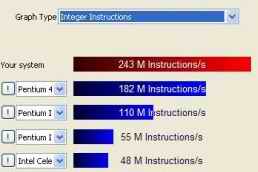
Hardware Extra
Thoroughbred AMD vs. Pentium Intel
And welcome to my GREAT, EXCLUSIVE testing of the HI-END Processors. The main purpose of this testing is to actually show AMD and Intel confrontation for the leading place in the processors world. Which processor is better ??? This is actually a good question. I'm not going to decide it, but you are... for yourself. So.... I decided to test 5 (!!!) different processors systems....
1) My system:
Processor - AMD Athlon XP CPU 1812 MHz
Motherboard - ASUS A7V-EX;
Chipset - VIA Apollo KT266 rev. A
L1 Cache - 128 KB
L2 Cache - 256 KB
Memory - 512 MB DDR SDRAM
AMD Athlon XP 2200+ (Thoroughbred Core)
2) 2nd System:
Processor - Intel Pentium 4 CPU 2.00 GHz
Motherboard - ASUS P3C-2000;
Chipset - Intel i845D rev. 4
L1 Cache - 32 KB
L2 Cache - 512 KB
Memory - 256 MB DDR SDRAM
Intel Pentium IV (Northwood) Core tested under Windows XP
3) 3rd System: Sony Vaio PCG-GR370 (Laptop)
Processor - Intel Pentium 3M 1133 MHz
Motherboard - ASUS P3C-2000;
Chipset - Intel i820
L1 Cache - 32 KB
L2 Cache - 512 KB
Memory - 256 MB SDRAM
Intel Pentium 3 (Coppermine) Core tested under Windows XP (Service Pack 1)
4) 4th System:
Processor - Intel Pentium 3B 533 MHz
Motherboard - ASUS P3C-2000;
Chipset - Intel i820
L1 Cache - 32 KB
L2 Cache - 512 KB
Memory - 256 MB SDRAM
Intel Pentium 3 (Katmai) Core tested under Windows XP (Service Pack 1)
5) 5th System:
Processor - Intel Celeron 466 MHz
Motherboard - ASUS P3C-2000;
Chipset - Intel i820
L1 Cache - 32 KB
L2 Cache - 128 KB
Memory - 64 MB SDRAM
Intel Celeron (Mendocino) Core tested under Windows 2000 (Service Pack 2)
Of course, first two systems are the most important in the testing. But I decided to put three more, because I wanted to show you the progress of processors at all and to check if Pentium 3 still wins in some tests if comparing it with AMD and Intel Pentium IV latest chips. So enjoy ... :-)
1) Integer Instructions

So AMD takes the lead in showing the full advantage in Integer instructions test against Intel. This test, as well as the next one, illustrates how fast processor digital registries work. The progress of Athlon XP 2200+ is quite big.
2) Floating-Point Instructions
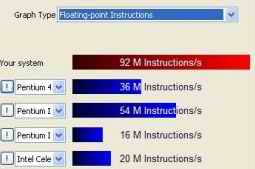
These instructions tests are actually AMD's because this company processors always show high results. But anyway, Athlon XP came first there as well. But lets take a look closer: Even Intel Pentium IIIM showed much higher results than Pentium IV. What happened ??? That's one of the main "holes" in the new Pentium 4 Speed theory of Intel. This test illustrates the rate of operations with numbers that have different point positions. So this point turns into a floating. The operations are called GLOPS. This describes the speed of digital registries as well.
3) MHz Score
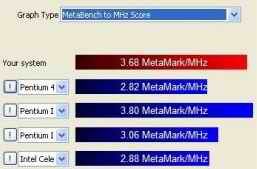
This is not just a stupid frequency rates re-written with a new speed coefficient. This is a REAL test of speed - one of Intel main advantages. It describes the combination processor-motherboard-memory. Actually, I expected Intel Pentium IV to win this even being with DDR but Athlon XP took the lead here. Maybe, the hardware combinations were a bit unfair for Intel but still... The results are actually quite strange, because Pentium 3 was tested under the same motherboard.
4) Memory filtrate memcpy
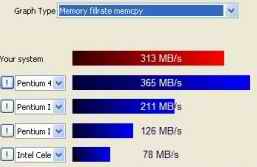
The rate of memory filtering is an important characteristic as well. Here Intel took its deserved advantage, although not so sure. Athlon XP got closer but Intel are still at the lead in this. One of their favorite tests I would say.
5) Memory filtrate Assembly 8bytes blocks
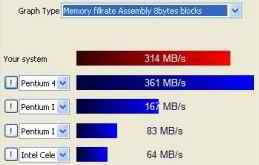
This tests shows the dealing with a simple, easy, small memory structures - 8 bytes blocks. And Pentium 4 took the lead here as well. At all, in these Assembly tests Pentium 4 was first but look at the next one from the same category.
6) Memory filtrate SSE moving 16 bytes blocks

I missed the same tests for 3DNow! because only Athlon XP supports it. But SSE is actually the favorite instructions technology of Intel (including SSE2) and we saw Athlon XP winning here. Of course, the lead is very unsure and unstable but still... This could be an evolutional moment for AMD as they optimized their processors quite fast and very well for SSE instructions that were primarily used by Intel.
7) Merge Sort
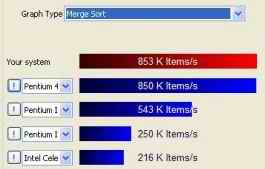
The sorting tests now. The first - merging test - shows the advantage of Athlon XP. But at all they are looking close with Pentium 4. Pentium III is not by far behind them. This one of equal tests as they are suitable for both processors.
8) Large Objects Sort
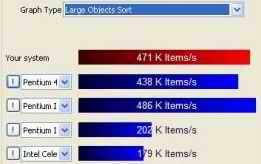
But in Large Objects sorting test Athlon XP got a sure win against Pentium 4... but not Pentium 3. This test illustrates that Pentium kept the primary Intel technology process although it didn't allow Intel to develop their interests in speed. But in sorting tests Intel showed a great result even overcoming Athlon XP.
9) Ogg Vorbis Audio Encoding
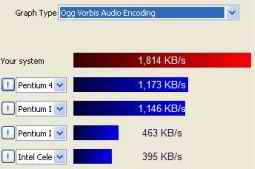
I chose Ogg Vorbis as just an example to show the audio encoding/decoding results. They are actually the same: Athlon XP took the fully deserved first place. Even in Lame package of codecs Athlon XP shows some brilliant results.
10) PPMD Compress Algorithm (Optimized)

This is the optimized technology of Compress Algorithm test. It shows the speed of compressing/decompressing by processor registries. And Athlon XP finished first here... as a result for this testing...
Resume
This was actually made during the testing. But anyway, you decide which processor would suite you or which is the best or fastest in your opinion. I missed some tests and decided not to show them but tried to illustrate the main characteristics of processor through 10 tests. Hope you liked it!
Peter L.
Published on 01.12.02 14:25 GMT